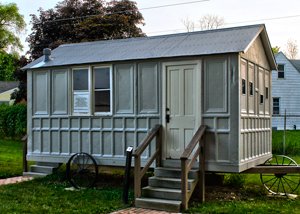Hilliard Ohio’s Historical Village
(Select HERE for a map of the Historical Village)
-

Colwell Chapel
The Village Chapel was originally the Colwell Methodist Church built in 1876 at the corner of Alton Darby Road and Roberts Road in the community of Mudsock. Its size is 1,053 sq. feet of frame construction and seats 110 people. The last service held in the church was May 3, 1964. It was vacant from this time until 1983 when it was moved to the Hilliard Historical Village. The church was a gift from Glen and Janet Anderson who had purchased the church and the land on which it sat from the Methodist Union with all its contents. The church has two wood burning stoves which can still be used when the church is used during cold weather. The pews, pulpit, kneeling bench, and two chairs are original to the church. There is an organ and a piano which was given to the society after the church was moved to the village. The bell tower houses the original bell of the church. Today, the chapel is used for weddings, special services, funerals, and for tour visitations. For more information, please see our Venue page.
-

School House
A one-room schoolhouse was part of the Norwich Township School District as early as 1814, the year after the township was formed. All one room schools were closed when the Consolidated Elementary School at Main and Cemetery Roads was built in 1917. The Grandview school was built in 1891 and was located on Cosgray Rd. It was moved to the Historical Village in 1977. Its size is 891 sq. ft. of joisted masonry.
Students from grades one through eight attended this school together. One teacher taught all eight grades. Older students helped younger students by tutoring them when they were having difficulty.
The school was a gift from John and Mary Hoffman. -

Caboose
The caboose was purchased for $1.00 in Kentucky and was delivered free to Ohio by the B & B Railroad to a C & O Railroad Siding on Neil Avenue in Columbus. It continued it journey to the Historical Village by the Atlas Transfer Company.
The Caboose is 215 square feet of frame construction. It was home to a conductor, a brakeman, fireman, and engineer when these men were with a freight train from one city to another. -

Covered Bridge
This is a reproduction of the 19th century lattice truss bridge designed by Ithiel Town of Connecticut. The bridge was erected by the Franklin County Engineers as a joint project with the Hilliard Parks and Recreation and the Historical Society. The bridge was built from materials that were salvaged from the Ashbrook covered bridge restoration project. The bridge is 28 feet long and eight feet wide and is one half the size of the original bridge. The roof is hand split cedar shakes.
-

Log Cabin
The log cabin is of the 1850 period of this area. It was constructed in 1982 from the best logs of three cabins of the area. These cabins were located on Elliot Rd., Eiterman Rd., and one located on another unknown site.
The cabin size in 495 sq. ft. of construction. The cabin has a wood floor downstairs, and an enclosed stairway leading to an upstairs bedroom. Both rooms of the cabin are equipped for pioneer living. All cooking was done in the fireplace using cast iron utensils. Clothes were sewn in the main room. Quilts were made, wool was spun, milk was churned, herbs were hung from the ceiling, and all other activities necessary were performed in the living room. Behind the cabin is the out house. It is a WPA outhouse (Works Progress Administration) and is a classic and vanishing architectural wooden building. It is now inoperable due to a more modern convenience known as a “restroom”. -

Train Station
The Columbus, Piqua Indiana Railroad began operation on July 4, 1853, in what was known as Hilliards Station. There was no train station until about 1895 when the Panhandle Line, as it was then called, put together three box cars and called it a station, located on Center Street. This station was replaced with the building pictured here in 1899 and was located on Center Street. It was closed in 1962.
The Station was used mainly for the shipping and receiving of goods by local merchants and farmers. Therefore it has only freight doors – no people doors. There was a waiting room for passengers waiting to go to Columbus or Plain City. The station was moved to the Historical Village Sept. 30, 1969. -

Granary
The Granary was moved from Brown Township and is of the 1850 vintage. It was moved next to the barn in 1985. It was a gift from Ben and Dave Sayre who had purchased the Old Bidwell Farm located on Amity Road. It is 180 square feet of wood construction measuring 16.5 feet by 12 feet.
-

Gazebo
A gazebo could often be found on the 19th century village green. The original gazebo of the village was built in 1983 with wings added in 1991. The gazebo shown replaced the original and was built by the City of Hilliard. It is used for outdoor weddings, concerts, and other outdoor activities.
-

Voting Booth
The voting booth measures 11 feet by 23 feet from the tongue to the rear and wheel to wheel. It is made of panels with two doors, three windows, and four voting areas. It was originally from Logan, Ohio, and then Wilson Road in Columbus. It was acquired from Judy Stanford who was the owner. The tin building rests on two iron wheels.
-

Kuhn's Barn
The barn and the cost of moving it was donated by Richard and Joan Kuhn. The barn was from their farm which was located between Rome-Hilliard Road and Walcutt Road. The barn was moved to the village in May, 1988. The barn is of frame construction and has a floor area of 480 square feet. Many small farm implements and tools are stored in the barn.
-

Railroad Signal
The Society purchased the railroad signal lights for $50.00. The lights were installed by Chris Leppert in July, 1987. The lights were from the Columbus, Piqua, and Indiana Railroad crossing on Main Street in Hilliard.
